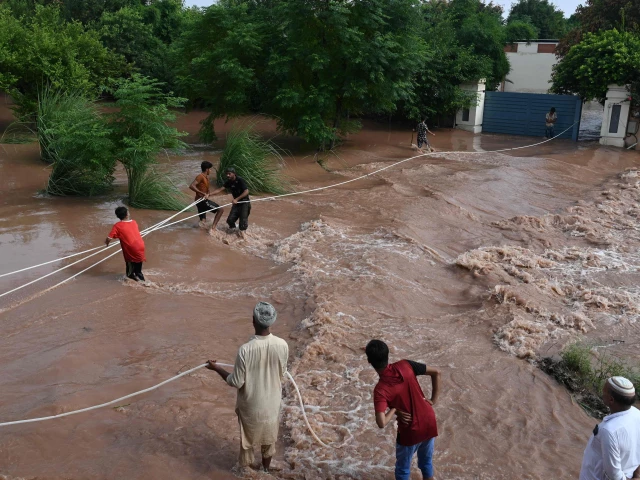New model uses AI forecasts to trigger cash transfers before overflows, helps families evacuate, protect assets
A citizen wades through the flooded area of Narowal, a town in Punjab, on August 27, 2025. Photo: AFP
With this year’s floods devastating rural areas and displacing countless families, it is more important than ever to have systems in place to anticipate and proactively provide assistance to affected populations.
The non-profit GiveDirectly is testing a new approach to flood relief, which is to send money to households before the water level rises. Anticipatory cash assistance uses AI to predict where floods will hit and releases payments when certain risk thresholds are reached.
GiveDirectly said it transferred US$105 to thousands of households in Nigeria within 48-72 hours of their expected flood thresholds in June, enabling families to evacuate, fortify homes and protect livestock ahead of flooding. The group also reported that “incomes more than doubled, food insecurity decreased by 90% and most beneficiaries felt better prepared for future floods”.
Read: Record floods displace millions in Punjab
The model relies on Google’s Flood Hub, a forecasting platform that now covers over 80 countries and offers up to seven days of flood forecasts. By leveraging Google’s AI systems, aid organizations and governments can use it to receive alerts at the village level, and Pakistan is among the countries covered.
Aid agencies argue that early payment is both more dignified and more cost-effective than traditional aid that comes after losses have mounted, and similar ideas have been tested in Bangladesh and other regions, with studies suggesting that pre-emptive action can shorten recovery time and reduce humanitarian costs.
How Pakistan can implement a similar system
Pakistan has real-time river data through the Pakistan Meteorological Department’s Flood Forecasting Division (PMD/FFD), and can use Google Flood Hub (and its AI systems) to monitor parameters such as predicted river discharge levels, flood probabilities, and so on.
By identifying and registering vulnerable households, such as through the Benazir Income Support Program (BISP), the government can create digital wallets to get funds to people as quickly as possible. BISP has already partnered with JazzCash for fund disbursements so this can be adapted for flood relief.
In addition, by linking PMDFFD’s flood hub forecasts to Pakistan’s Space and Upper Atmosphere Research Commission (SUPARCO) Space Application Center for Response in Emergencies and Disasters (SACRED) satellites, we can refine the data to high accuracy and ensure precise targeting of settlements at risk.
By integrating “preemptive action” into the National Disaster Management Authority’s proactive monsoon guidelines and using the National Disaster Risk Reduction Strategy for 2025–2030 we can both plan for the floods and to take care of our people before the floods, clarify how vulnerable people get payments and the conditions for getting these payments. There may also be a verification system to check errors and fraud integrated into the policy framework.
However, special consideration must be given to people in areas that do not receive consistent cell phone signals or those who are not digitally connected.
Trials a system in Sindh’s lower Indus and southern Punjab, where the flood risk is high, with the help of an independent partner will be a good first step towards a system that can save and support many.



